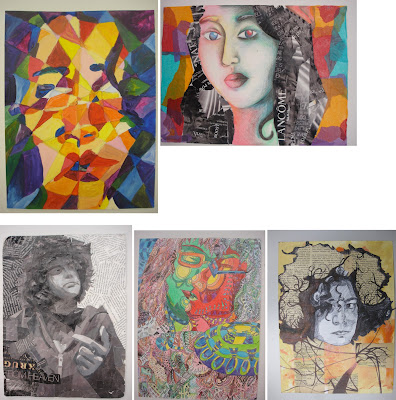Create two mixed-media portraits on Bristol board. One self-portrait, and one portrait of a friend or family member. Through the process, you will begin to explore additive technique in two-dimensional art. In particular, you will experiment with integrating collage with traditional painting and drawing techniques.
Attention will be given to the design principles we covered first semester. Namely: (F/G relationship, balance, composition, value, and color theory/relationships). All elements must work together to create a cohesive, resolved, and finished work.
Due Dates (Critiques)
Lambert's Class: Tue, March 17th.
Samimmy's Class: Wed, March 18th. Rubric
You will be assessed on your application of the design principles mentioned above, your craftsmanship, and your creativity.
Note: All projects turned in after the due-date will be reduced by one letter grade.
Materials
- White Bristol board 18in. x 12in. This sheet will be cut into two 9in. x12in. pieces.
- Paint, markers, colored pencils, etc.
- Fabric scraps, magazine cutouts, thin metals, plastics, etc.
- Appropriate adhesive (white glue, rubber cement, gel medium)
Process
Step 1
In your sketchbook, create 5 different contours (silhouettes) that you will use as a reference for your collage.
Begin by drawing yourself with a mirror. Pay close attention to details, such as facial features, and their relative size and position to one another. Be sure to map all these elements out correctly. Use cropping and position on paper to create a dynamic composition.
Draw a silhouette of the head, then include neck and shoulders, add hair, include ears... Think about what you could add/remove to make it unique (pencil behind ear, sunglasses in hair, specific earring, etc)
Step 2
Now, focus on other areas of your body- hands, feet, legs, and entire figure. Repeat the steps above, to create 5 more contours from these observational drawings.
Step 3
Tape the compositions to a wall, take a step back, and examine at your contours. Examine the positive/negative space, and composition, of each contour. Which are most successful?
Now, look at the compositions alongside each other. Pay attention to the different ways the compositions interact with each other. How do they inform (relate and influence) each other? What combinations of compositions are particularly successful?
Step 4
Based on the observations in Step 3, choose one (or more) compositions to use as a starting point. Find ways to make the composition stronger, by overlapping, intersecting, combining, cutting, cropping, etc. Continue to refine the composition by rearranging, adding, and deleting elements.
Step 5
Explore with different materials (paint, collage, markers, fabric, metal, etc), continuing to refine the composition. Use color, texture, and value to tie everything together.
NOTE: THIS IS NOT A 3-D PROJECT; KEEP THE WORK 2-D.It can have lots of texture, and some depth, but the bristol board must be able to physically support all the materials you have incorporated.
Art-Historical Examples
Andy Warhol
Students Samples
